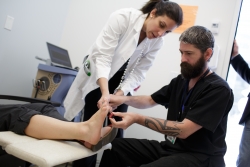Study shows pain causes older adults to develop more inflammation over a longer period of time
Published: May 4, 2016 By: Morgan Sherburne
When older relatives complain about their pains, show a little empathy, because new research suggests that as we age, we may all become more sensitive to pain. A small, preliminary University of Florida Health study has suggested for the first time that inflammation may occur more quickly and at a higher magnitude — and stays around longer — when older adults experience pain versus when younger adults experience pain.
This could mean that older adults could be at risk for developing chronic pain and may benefit from taking anti-inflammatories soon after an injury or procedure, according to the researchers.
Older adults often have a certain level of chronic inflammation in their bodies. But UF researchers found that when they induced pain in older adults, proteins associated with inflammation increased more than they did in younger participants and stayed in the bodies of older adults longer. The researchers also found that anti-inflammatory cytokines, proteins that soothe inflammation, peaked later for older adults than younger adults. Their results were published in a previous issue of Experimental Gerontology.
“Older people go through painful procedures more often, and we wanted to research whether this accumulation of painful procedures or more acute pain episodes that older people encounter is bad,” said Yenisel Cruz-Almeida, Ph.D., MSPH, an assistant professor in the UF College of Medicine’s department of aging and geriatric research who also is affiliated with the UF Institute on Aging. “If you have enough of those in a shorter period of time, does this predispose you to have chronic pain?”
When older adults have this kind of elevated inflammatory response, they’re more likely to have pain generated in the periphery of the body — their tissue and limbs outside of the spinal cord and brain, said the study’s senior author Joseph Riley, Ph.D., director of the pain clinical research unit in the UF Pain Research and Intervention Center of Excellence.
“If older adults are more likely to have these pain messages sent through the spinal cord to the brain, and the nervous system is being adapted to go through these changes, they may become more pain prone,” said Riley, also a professor in the UF College of Dentistry’s department of community dentistry and the UF College of Public Health and Health Professions’ department of clinical and health psychology.While the study does not establish whether accumulation of acute pain predisposes older adults to chronic pain, the researchers say their findings suggest this is a possibility, and it’s the first step in pain research to further understand the relationship between pain and aging. The researchers said the study’s sample size, though small, was more than adequate to demonstrate large differences between the older and younger adults they tested. The differences in inflammation within each group varied very little compared with the overall difference between the two groups, which suggests the populations they sampled were very different and there was little chance of sampling error, Riley said.
Cruz-Almeida and Riley studied eight healthy older adults, whose average age was 68, and nine healthy younger adults, whose average age was 21. None of the participants had illnesses such as diabetes or hypertension. During an initial visit, researchers induced pain in the participants in two ways, either using heat applied to the feet or a cold ice bath.
The first session determined how sensitive the participants were to pain. Determining a tolerable temperature allowed the researchers to recreate the same amount of pain for each participant in the subsequent sessions.
Participants rated their pain on a scale from 1 to 10. The researchers were aiming to induce pain to a Level 4 — a level that created the painful stimuli the researchers needed, but didn’t dissuade the participants from returning for the other visits required in the study.

With a thermode — a device that looks like a microphone with a copper tip — the UF researchers applied heat to the feet of participants in a study that tested the inflammatory response to pain of older adults versus younger adults.To study inflammation in the blood, the scientists inserted a catheter into each participant before inducing pain. That allowed them to collect the participant’s blood before the pain stimulus and then at three, 15, 30, 45, 60 and 90 minutes after the stimulus. These blood samples allowed the researchers to study inflammatory markers in the blood, finding that older adults had higher levels of inflammation when pain was induced than the younger adults.
Riley said activation of the immune system and increased inflammation are not necessarily harmful, but it’s important to understand how the length of time the immune system is activated affects the body.
“We think that the longer you have the immune system activated, having these elevated inflammatory cytokines, the more this activation can alter the homeostasis of the body. Usually an imbalance like that can be associated with autoimmune disorders, which also increase with age,” Cruz-Almeida said. “But the truth is we don’t know what the direct implications would be. We think low-grade inflammation is related to endocrine abnormalities such as diabetes and the development of heart problems. … We need to keep looking and doing future research.”
Riley said immediate implications of the research for patients could be to attack pain quickly with anti-inflammatory medication.
“Early treatment of an injury even with over-the-counter anti-inflammatories may be a good idea,” Riley said. “It’s those first few days of bombarding the central nervous system with pain signals that has a bigger effect (on the body).”
About the Author
Morgan Sherburne
Science writer for UF Health. Morgan writes about the research of faculty physicians in the College of Medicine. She joined the UF Health staff in 2014. A Michigan native, she...Read More
https://ufhealth.org/news/2016/study-shows-pain-causes-older-adults-develop-more-inflammation-over-longer-period-time

No comments:
Post a Comment
All comments welcome but advertising your own service or product will unfortunately result in your comment not being published.